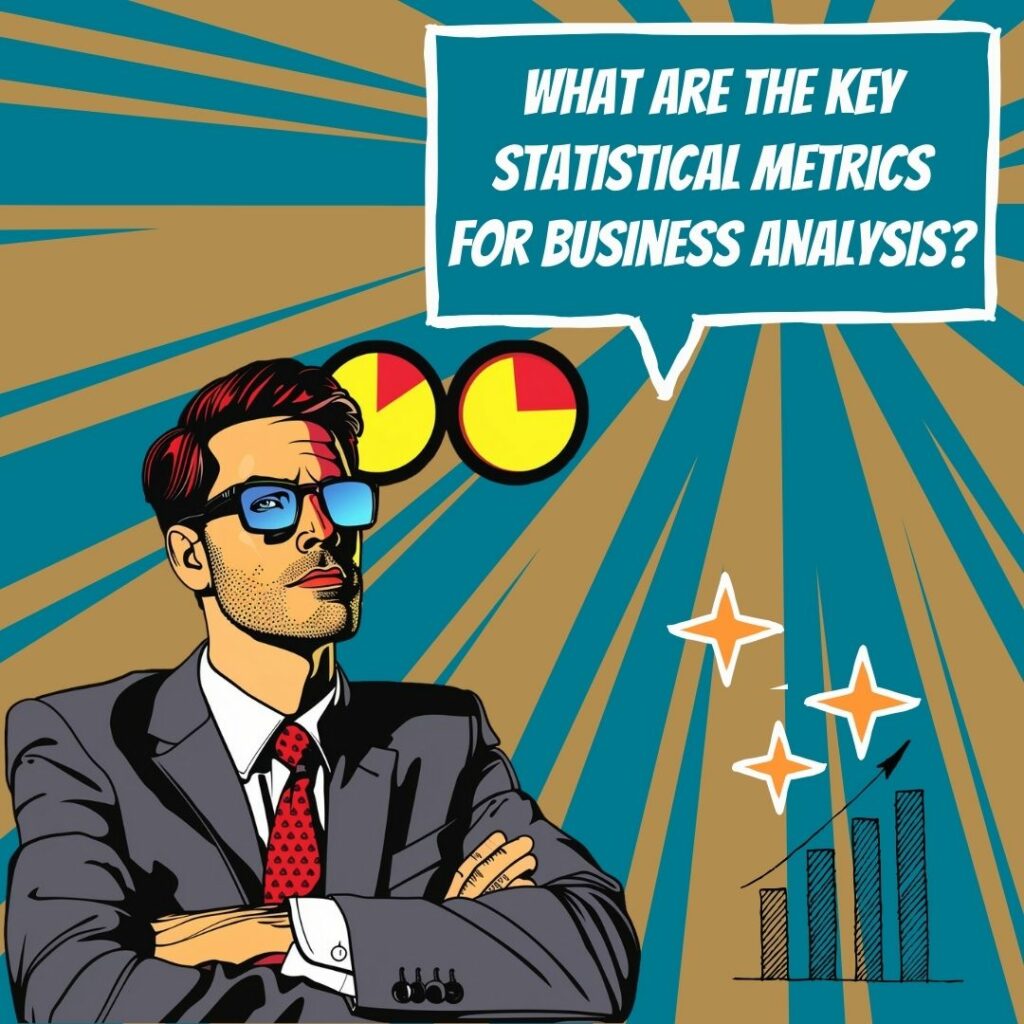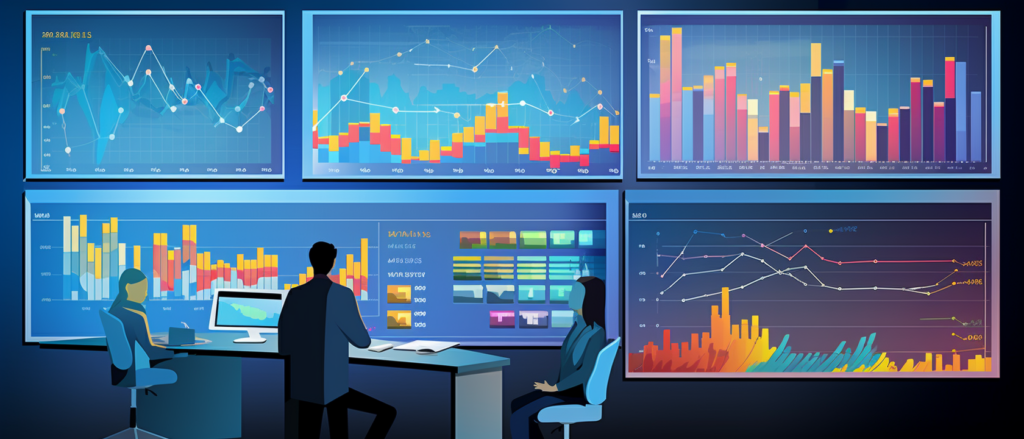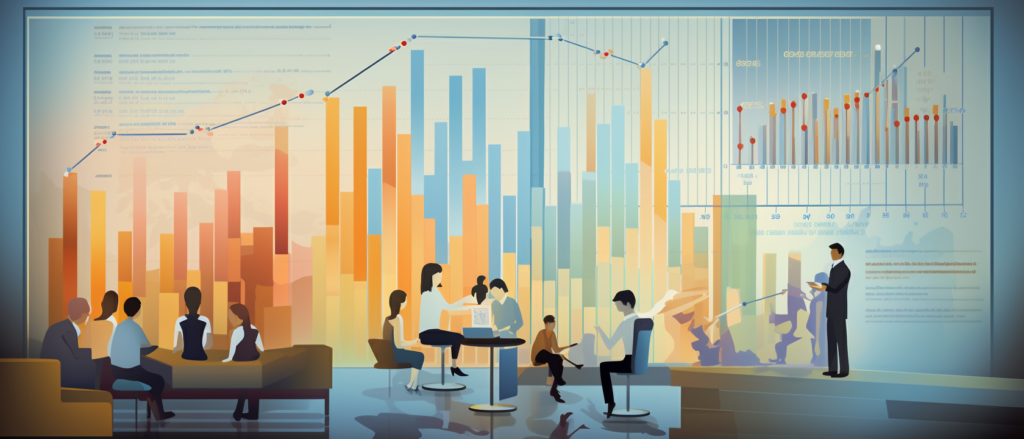Key Takeaways
✅ Data-Driven Decision-Making: Businesses that base decisions on hard data often find themselves ahead of the curve. With the right statistics, you can spot business trends, understand market patterns, and get a clear picture of where you stand—giving you the power to make smarter, more effective business choices.
✅ Customer Behavior and Preferences: Ever wondered what makes your customers tick? Statistical insights can be the looking glass into your customers’ minds. By picking apart data on what they buy, how they shop, and what they say, you can better satisfy their cravings—leading to happier customers and a healthier bottom line.
✅ Performance Measurement and Optimization: How do you know if your business is really doing well? Throwing darts in the dark won’t help, but statistics will. By understanding key metrics like sales and customer satisfaction, you can identify what works, fix what doesn’t, and steer your business toward success.

Introduction
Have you ever felt like you’re making business decisions in the dark? Here’s a light switch: statistical insights. Let’s face it, running a business without data is like trying to hit a bullseye blindfolded. What if you knew more about what’s working and what’s not? What if you could predict what your customers will want next month or next year?
In “Unlocking the Power of Statistics for Business Success,” we’re diving into the world of data to uncover the key performance indicators (KPIs) that matter, the secrets behind effective data collection, and cutting-edge predictive analytics. It’s not just about numbers; it’s about understanding what they mean for the heartbeat of your business—your customers, your sales, and your growth.
Stay tuned as we bring you modern trends and solutions that could change the game for your revenue. Imagine maximizing your return on ad spend (ROAS) or investment (ROI) with insights that tell you exactly where to bet your dollars. Sounds incredible, right?
By the end of this piece, you’ll walk away with actionable insights and groundbreaking information that can turn data into your most valuable ally. We’re on a mission to empower your business to not just survive, but thrive with the power of statistical insight. Let’s embark on this journey together, shall we?
Top Statistics
| Statistic | Insight |
|---|---|
| Global eCommerce Growth: Sales projected to reach $5.4 trillion in 2022, a 16.8% increase from the previous year. (Source: Statista) | This growth wave signals a golden opportunity for businesses to dive into the digital marketplace and expand their online presence. |
| Mobile Commerce Dominance: Expected to account for 72.9% of all eCommerce sales in 2021. (Source: eMarketer) | The dominance of mobile commerce illustrates the necessity of having a mobile-friendly shopping experience to capture the mobile-first consumer. |
| Social Commerce: Sales in the US expected to reach $36.62 billion, a 35.8% increase. (Source: Insider Intelligence) | This boom shows that integrating shopping experiences with social platforms could be a smart play for companies aiming to engage more closely with customers. |
| Remote Work Trend: 16% of companies are fully remote & 62% of employees want to work remotely at least part-time. (Source: Owl Labs) | Adapting to remote work is no longer a nice-to-have but a must, as flexible work arrangements are becoming a key factor for employee retention and satisfaction. |
| Generational Shift: Millennials are now the largest adult generation in the US. (Source: Pew Research Center) | Understanding the values and spending habits of Millennials is crucial for businesses wishing to stay relevant and effectively target this influential demographic. |
The Importance of Statistical Insights
Have you ever wondered how businesses seem to always know what you want? Well, it’s not magic—it’s statistics at play. Data-driven decisions are the engines behind today’s most successful companies. They sift through heaps of data to spot trends and patterns that can translate into a solid business strategy. Employing statistical insights for strategic planning isn’t just fancy number-crunching; it’s about finding a storyline in the data that guides growth. And honestly, who doesn’t want their business to grow?
Understanding Key Performance Indicators (KPIs)
Now, let’s chat about KPIs—you’ve probably heard the term thrown around. Key Performance Indicators are like the business world’s report card. They tell you if you’re acing the class or if you need a little more tutoring. KPIs vary—some businesses track dollar signs as revenue, others care about how many customers stick around (customer retention), and then there’s the buzz about conversion rates. It’s all about knowing what numbers give the truest picture of your business’s health.
Data Collection and Analysis
Think of data collection and analysis like gathering ingredients and following a recipe to bake a cake. You need the good, fresh ingredients (that’s the accurate data), and you need to mix them just right (hello, data cleaning and transformation) to make a cake worth serving (or in our case, actionable insights). And to bring everyone to the table, a beautiful presentation—or data visualization—helps everyone understand why they’ll want a slice.
Descriptive Statistics: Measuring Business Performance
If you want a snapshot of your business performance, descriptive statistics are your go-to. Think about when you summarize a story to a friend—you’re not giving a line-by-line recital, just the juicy bits, right? Similarly, descriptive stats summarize stacks of data using averages and ranges. Tools like frequency distributions, histograms, and box plots then lay it all out in neat diagrams. It’s storytelling with numbers.
Inferential Statistics: Drawing Conclusions from Data
Ever feel like making a business choice is a shot in the dark? Inferential statistics bring in the flashlight. This set of tools helps you make educated guesses—predictions, really—based on data samples. Whether you’re comparing groups with a t-test, analyzing variance with ANOVA, or exploring relationships with regression analysis, you’re turning informed prediction into a bit of an art form.
Predictive Analytics and Forecasting
Speaking of the future, predictive analytics is like having a crystal ball, but for data. Rather than guesswork, businesses use models like decision trees, neural networks, and time series analysis to forecast what’s around the corner. It’s about making the best-educated guess on what tomorrow might bring. Can you imagine the power that lies in making decisions today that are rooted in knowledge about future trends?
Integrating Statistical Insights into Business Strategy
In the story of business success, data-driven decision-making plays the starring role. It’s critical for businesses to not just collect numbers, but to understand and act on them. This means regular folks in a company, not just the geek squad, should get what the data is saying. It’s all hands on deck to strategically use insights from statistics to stay afloat—and to sail the competitive seas of today’s business world. By weaving statistical insights into the very fabric of business strategy and operations, companies can not only predict future scenarios but also craft narratives that resonate with customers, standing out in a crowded market.
AI Marketing Engineers Recommendation
Recommendation 1: Keep an eye on customer churn rates: It’s like knowing who’s leaving the party early. If your customers are leaving faster than they’re coming in, you’ve got a problem, right? Dive into your data and calculate your churn rate—the percentage of customers who cut ties with your service or product over a given period. If that number starts creeping up, it’s like an alarm bell warning you to check what’s going on. Is it your product, your service, or maybe something else? Take action by finding patterns and addressing those issues quickly to keep your customers around for the long haul.
Recommendation 2: Harness the power of purchase behavior analytics: What if you could predict what your customers want before they even know they want it? By analyzing trends in purchase behavior, you can. Look at what, when, and how often customers buy, and use that data to forecast future buying trends. With the rise of e-commerce, there’s a goldmine of data out there on purchase behavior, telling you what’s hot and what’s not. Tailor your inventory, marketing efforts, and sales strategies to align with these insights. It’s a bit like having a crystal ball, but it’s all data, not magic.
Recommendation 3: Utilize a robust A/B testing platform: Imagine if you could test drive your business decisions before fully committing—you can with A/B testing. It allows you to compare two versions of something, maybe a web page or an ad, and see which one performs better. Using an A/B testing tool like Optimizely or Google Optimize can remove the guesswork from your decisions. This isn’t just useful; it’s essential when it comes to fine-tuning your marketing strategy. Want to know if a red button brings in more sales than a blue one? A/B test it. Want to see if customers respond better to one headline over another? A/B test it. It’s all about having that direct feedback loop to refine what works best for your audience.
Relevant Links
– Affiliate Marketing Mastery: Earn Passive Income Effortlessly
– Maximize Your Impact: ChatGPT for Powerful SEO and Content Strategies
– Visualize Success: The Power of Data in Enhancing Your Business Strategy
– Level Up Your Business with AI: The Future of Marketing Analytics
– Discover Cutting-edge Marketing Trends to Dominate 2024
– Revolutionizing E-Commerce: The AI Advantage for Unmatched Growth
– Boost Conversion Rates: The SEO Game Changer Every Business Needs
– Unlock the Blueprint for Digital Marketing Success in 2024
Conclusion
Well, we’ve journeyed through the landscape of numbers and patterns, haven’t we? It’s time to take a step back and ask ourselves, “What have we learned from all this?” It’s clear that those nifty statistical insights that we’ve talked about aren’t just numbers on a screen – they’re the compass that can guide businesses through the wild seas of the market.
Think about it – those Key Performance Indicators (KPIs) are like a lighthouse, aren’t they? They light the way, showing us if we’re sailing towards success or if we’re about to hit rocky shores. Whether it’s keeping an eye on revenue or making sure customers stick around, KPIs are always there, keeping things in check.
And when it comes to the nuts and bolts – the collecting, cleaning, and making sense of data – isn’t it kind of like preparing for a big voyage? You wouldn’t set sail without the right provisions and a good map, would you? The same goes for data. You need that solid foundation of well-prepared data to spot the trends and make your predictions.
Descriptive and inferential statistics, along with predictive analytics, are not just fancy terms. They are powerful tools, like a captain’s trusted binoculars, giving you the ability to look far ahead and navigate towards opportunity or away from danger.
FAQs
Question 1: What are the fundamental statistical concepts important for businesses?
Answer: Oh, there are a few key players here, and by that I mean the concepts that really get the work done. Think of mean, median, and mode—they boil down all that data to give us the gist of what’s going on. Then you’ve got your standard deviation and variance, which tell you how much your data is dancing around. And, of course, probability and those spooky-sounding probability distributions—it’s like playing the odds, knowing what might come up next. Finally, we can’t forget about correlation and regression; these help us understand how two things relate and what might happen as a result.
Question 2: How can statistical analysis improve business decision-making?
Answer: You know, it’s like having a crystal ball but with numbers. Statistical analysis digs through all the clutter to spot patterns and trends—kind of like finding the method to the madness. It helps businesses forecast what’s likely to happen, assess risk, and even make sure they’re using their resources in the smartest way possible.
Question 3: What are the common statistical techniques used in business analytics?
Answer: Businesses have a toolkit they rely on: descriptive statistics, which are like the highlight reel for data; inferential statistics, which help us make educated guesses; regression analysis, the detective that uncovers relationships between things; and time series analysis, which looks at how stuff changes over time.
Question 4: How can businesses use statistical analysis to improve customer satisfaction?
Answer: It’s a little bit like mind reading. Companies can comb through customer feedback and behavior patterns to make things better and to personalize experiences. Predictive modeling is another neat trick to guess what customers will want next. And they keep an eye on things like customer retention rates to make sure they’re on the right track.
Question 5: What are the best practices for communicating statistical insights to non-technical stakeholders?
Answer: Picture this: rather than bombarding them with numbers and technical mumbo-jumbo, you use charts or graphs that tell the story at a glance. Stick to the main points that can spark action and paint a picture of what it means for the business. Keep it simple, keep it real.
Question 6: How can businesses ensure the quality and reliability of statistical data?
Answer: It’s all about the ingredients, really. Start with quality data from sources you can trust, clean it up, double-check it, and then use solid statistical methods to cook up your findings. And never stop tasting and tweaking—that’s how you keep your insights fresh and relevant.
Question 7: What are the advanced statistical techniques for businesses looking to gain a competitive edge?
Answer: If a business wants to be the smartest in the room, it turns to things like machine learning and AI. It helps them predict things with freaky accuracy. There’s also cluster analysis, which is a fancy way of grouping things to better understand customer segments or products. And let’s not forget about text mining and NLP, where businesses dive into words and sentences to figure out what people are really saying.
Question 8: How can businesses use statistical analysis to optimize marketing campaigns?
Answer: Imagine knowing exactly who to talk to and what to say. That’s what analyzing customer data does—it shows who your audience really is. And by looking at how well a campaign’s going, like how many people click or buy, you can tweak things on the fly. A/B testing is pretty handy too—it’s like a head-to-head challenge to see which strategy wins.
Question 9: What are some common statistical pitfalls businesses should avoid?
Answer: Ah, the classic blunders. You could have the best-looking model out there, but if it’s too complicated and can’t handle fresh data, that’s overfitting. Then there’s confirmation bias, where you only see what you want to see in the numbers. And don’t get too caught up on something being statistically significant—it might not actually matter in the real world.
Question 10: How can businesses stay up-to-date with the latest statistical insights and techniques?
Answer: It’s all about staying curious and connected. Go to events, get your hands on new resources, and never stop learning. Keeping an eye on the latest buzz in your field and making sure your team is always sharpening their skills—that’s how you stay ahead.
Academic References
- Shmueli, G., Bruce, P. C., Patel, N. R., & Yahav, I. (2016). Data Mining for Business Analytics: Concepts, Techniques, and Applications. Wiley. This book underscores the relevance of statistical methods in decoding the complex data landscape that businesses navigate, with a special focus on visualization, predictive modeling, and decision-making processes.
- Nisbet, R., Elder, J., & Miner, G. (2009). Statistical Analysis and Data Mining Applications. Springer. Delving into stats, this resource unpacks how discerning patterns in customer behavior, tweaking marketing tactics, and financial gains are all part of the statistical adventure that can redefine a business’s trajectory.
- Montgomery, D. C. (2013). Statistical Quality Control. Wiley. With a lens on ensuring supreme quality and cutting excess, this book talks about the instrumental role of statistical process control in the heart of business operations and the constant quest for excellence.
- Askin, R. G., & Standridge, C. R. (2011). Statistical Methods for Improving and Optimizing the Supply Chain. Wiley. A dive into the intricate world of supply chains, this reference sheds light on how the statistical toolkit can be a game-changer for managing inventories, predictions, and logistics.
- Schmuller, J. (2017). Statistical Analysis with R For Dummies. Wiley. Praised for its hands-on approach, this guide is the golden ticket for those eager to apply statistical analysis to real-world business puzzles, covering crucial topics such as visualization techniques, hypothesis testing, and regression analysis.












